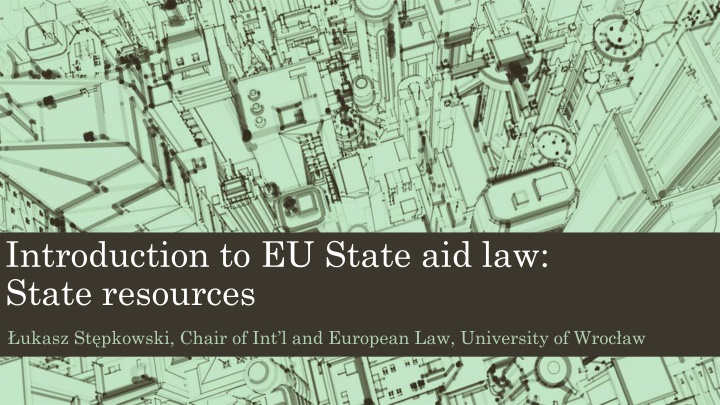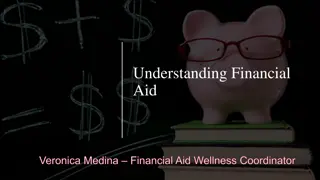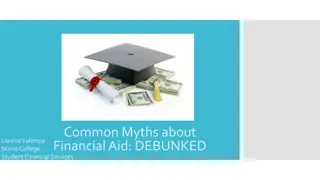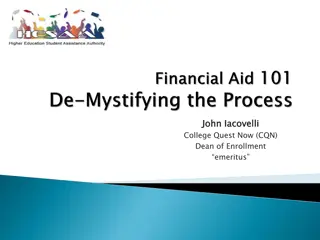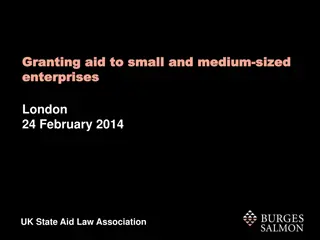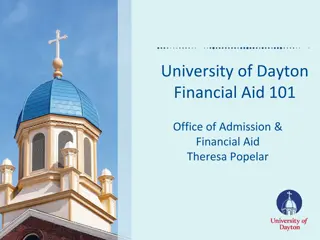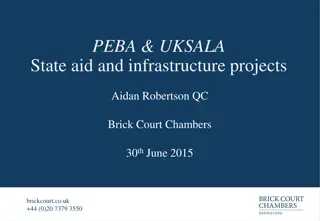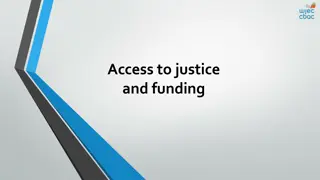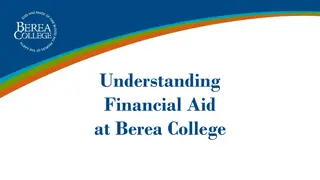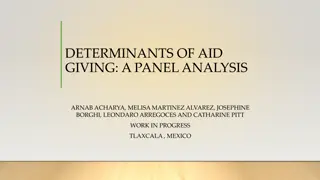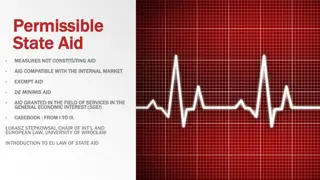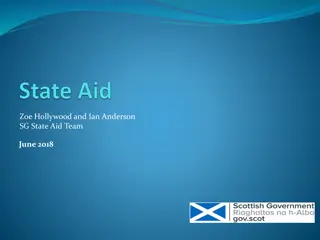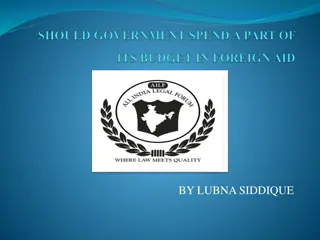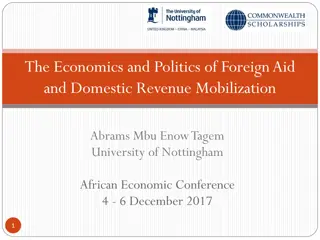Introduction to EU State Aid Law: State Resources and Prerequisites
State aid in the EU involves any assistance granted by a Member State, or through state resources, that distorts competition. The criteria for identifying state aid include intervention by the state, impact on trade between Member States, conferring an advantage, and distorting competition. The European Court of Justice has established judicial requirements for determining the existence of state aid, which involve imputability to a Member State and the involvement of state resources. This overview delves into the legal framework and key concepts essential for understanding EU state aid law.
Download Presentation

Please find below an Image/Link to download the presentation.
The content on the website is provided AS IS for your information and personal use only. It may not be sold, licensed, or shared on other websites without obtaining consent from the author.If you encounter any issues during the download, it is possible that the publisher has removed the file from their server.
You are allowed to download the files provided on this website for personal or commercial use, subject to the condition that they are used lawfully. All files are the property of their respective owners.
The content on the website is provided AS IS for your information and personal use only. It may not be sold, licensed, or shared on other websites without obtaining consent from the author.
E N D
Presentation Transcript
Introduction to EU State aid law: State resources ukasz St pkowski, Chair of Int l and European Law, University of Wroc aw
Prerequisites for State aid : 107(1) TFEU & case law Save as otherwise provided in the Treaties, any aid granted by a Member State or through State resources in any form whatsoever which distorts or threatens to distort competition by favouring certain undertakings or the production of certain goods shall, in so far as it affects trade between Member States, be incompatible with the internal market. The Court of Justice of the European Union usually fashions 107(1) TFEU into several judicial requirements for the existence of a State aid measure, that is : First, there must be intervention by the State or through State resources, Second, the intervention must be liable to affect trade between Member States, Third, it must confer an advantage on the recipient, Fourth, it must distort or threaten to distort competition (ex judgment of the Court of 1 July 2008, joined cases C- 341/06 P and C-342/06 P Chronopost SA and La Poste v Union fran aise de l express (UFEX) and Others, ECLI:EU:C:2008:375, para. 122, judgment of the Court of 9 October 2014, case C-522/13 Ministerio de Defensa and Navantia SA v Concello de Ferrol, ECLI:EU:C:2014:2262, para. 20). Some decisions phrase these requirements differently, e.g. as 1) the financing of a measure by the State or through State resources, 2) the selectivity of that measure, and 3) its effect on trade between Member States and the distortion of competition resulting therefrom (ex judgment of the Court of 19 March 2015, case C-672/13 OTP Bank Nyrt v Magyar llam and Magyar llamkincst r, ECLI:EU:C:2015:185, para. 38). Literature notes that the Court does not adhere rigidly to the actual wording of 107(1) TFEU (Bacon, European Union Law of State Aid, Oxford 2013, p. 20).
The Or Is Actually An And Perhaps the most unorthodox of the Court s approaches to 107(1) TFEU is the reformulation of the criterion that there should be a measure done by a Member State or state resources The Court treats the or as an and , meaning that the measure should be at the same time imputable to a Member State and involve State resources, either directly or indirectly The basic relevant authority is judgment of the Court of 13 March 2001, case C-379/98 PreussenElektra AG v Schhleswag AG, in the presence of Windpark Reu enk ge III GmbH and Land Schleswig-Holstein, ECLI:EU:C:2001:160, para. 61 : a measure that is imputable to a Member State, but does not involve State resources, deemed not to be aid Therefore, in newer jurisprudence the questions of imputability (attributability to a Member State) and the use of State resources are usually considered together ( for it to be possible to classify advantages as State aid, first, they must be granted directly or indirectly through State resources and, secondly, that grant must be attributable to the State , ex Judgment of the Court (Second Chamber) of 19 December 2013, case C-262/12 Association Vent De Col re! F d ration nationale and Others v Ministre de l cologie, du D veloppement durable, des Transports et du Logement and Ministre de l conomie, des Finances et de l Industrie, EU:C:2013:851, para. 16)
State resources The most obvious way of using State resources is a direct cash grant from the State treasury or another body that either can be classified as a State for the purposes of 107(1) TFEU, e.g. a unit of local government or an entity governed by public law (separate legal personality notwithstanding), with or without use of intermediaries where applicable However, the influence on State resouces need not be direct, as indirect measures also may constitute those that fall within EU State aid rules To that end, measures not involving a transfer of State resources may fall within the concept of aid, as the concept of intervention through State resources is intended to cover, in addition to advantages granted directly by the State, those granted through a public or private body appointed or established by that State to administer the aid (ex case C-262/12 Association Vent De Col re, paras 18-19) Article 107(1) TFEU covers all the financial means by which the public authorities may actually support undertakings, irrespective of whether or not those means are permanent assets of the public sector. Therefore, even if the sums corresponding to the measure in question are not permanently held by the Treasury, the fact that they constantly remain under public control, and therefore available to the competent national authorities, is sufficient for them to be categorised as State resources (ex case C-262/12 Association Vent De Col re, para. 20)
Use of State resources - examples a direct grant a loan soft loans ESPECIALLY subordinated loans a security a guarantee (even where not actually paid) a promissory note forfeiting a security selecting less efficient securities for enforcement factoring and forfeiting facilities a letter of credit capital measures capital injections capital payments (by a member of a company or a partnership) additional capitalisation of a company tax measures (usu. where tax revenue is forgone) full tax exemptions tax deductions Special taxation zones , usu. constituted for regional development Factual measures (where an amount of State resources is not paid, but it could be paid or could be paid in a higher amount) Deferred payments Abstention from enforcement Less efficient method of enforcement (usu. where a State forgoes to institute compulsory liquidation proceedings)
Possible burden on State resources Measures that are potentially able to constitute a direct or indirect use of State resources are caught by Article 107(1) TFEU There is no requirement of a demonstration that State resources have been transferred (Case C-387/92 Banco de Cr dito Industrial SA, now Banco Exterior de Espa a SA v Ayuntamiento de Valencia, para. 14 - no smoking gun requirement) The need to prove a sufficiently concrete economic risk (even if it is only a possible burden) Some jurisprudence: Judgment of the Court of First Instance of 13 June 2000, joined cases T-204/97 and T-270/97 EPAC - Empresa para a Agroalimenta o e Cereais, SA v Commission of the European Communities, ECLI:EU:T:2000:148, para. 80 (guarantee), C-200/97 Ecotrade, para. 43 (guarantee, waiver in practice of public debts, exemption from the obligation to pay fines or other pecuniary penalties, or a reduced rate of tax), judgment of the Court of 29 November 2012, C-262/11 Kremikovtzi AD v Ministar na ikonomikata, energetikata i turizma i zamestnik-ministar ECLI:EU:C:2012:760, para. 24 (cancellation of debts owed to the State, the use of State resources to pay other debts, and favourable credit terms), na ikonomikata, energetikata i turizma, judgment of the Court of 19 March 2013, joined cases C-399/10 P and C-401/10 P Bouygues SA and Bouygues T l com SA v European Commission and Others, ECLI:EU:C:2013:175, para. 106, case C- 275/10 Residex Capital IV, para. 42.
Possible burdens on State resources - continued if there is an intermediary involved for the purposes of allocating advantages, an additional charge for that body due to grant of an advantage satisfies the criterion of State resources State resources also become involved if a beneficiary is put by a measure in a more financially advantageous position, with the State forgoing additional revenue (ex judgment of the Court of 17 June 1999, case C-295/97 Industrie Aeronautiche e Meccaniche Rinaldo Piaggio SpA v International Factors Italia SpA (Ifitalia), Dornier Luftfahrt GmbH and Ministero della Difesa, ECLI:EU:C:1999:313, para. 35, judgment of the Court of 29 June 1999, case C- 256/97 D m nagements-Manutention Transport SA (DMT), ECLI:EU:C:1999:332, para. 18) In sum : Measures which, in various forms, mitigate the burdens normally included in the budget of an undertaking, and which therefore, without being subsidies in the strict meaning of the word, are similar in character and have the same effect, are considered to be aid
The burden of proof in regard to potential uses of State resources there must be a sufficiently direct link between the advantage granted and the burden at least risked by the State or an intermediary due to the aid measure, which the Commission must establish C-279/08 P European Commission v Kingdom of the Netherlands, para. 111 ( a sufficiently direct connection between the measure in question and the loss of revenue ) and C-399/10 P and C-401/10 P Bouygues SA and Bouygues T l com SA, para. 109 ( sufficiently direct link between, on the one hand, the advantage given to the beneficiary and, on the other, a reduction of the State budget or a sufficiently concrete economic risk of burdens on that budget ). In hard cases, it is difficult to prove that a potential transfer of State resources and the Commission has to either find a smoking gun or to be procedurally creative with its information injuctions under State aid procedures
State resources and an advantage it is not necessary that such a reduction, or even such a risk, should correspond or be equivalent to that advantage, or that the advantage has as its counterpoint such a reduction or such a risk, or that it is of the same nature as the commitment of State resources from which it derives C-399/10 P and C-401/10 P Bouygues SA and Bouygues T l com SA, para. 110. Compare judgment of the Court of 14 January 2015, case C-518/13 The Queen, on the application of Eventech Ltd v Parking Adjudicator, ECLI:EU:C:2015:9, para. 40, wherein an undertaking was explicitly permitted for a measure, rather than was forgone as to possible fines
Exemptions to the uses of State resources a finding that State resources are being used may be precluded by the fact that advantage is conferred on an undertaking by virtue of European Union law, that there is no burden borne by the State adjacent to an advantage or no advantage and no burden at all. See judgment of the Court of 14 July 1998, case C-341/95 Gianni Bettati v Safety Hi-Tech Srl, ECLI:EU:C:1998:353, para. 74. judgment of the Court of 7 May 1998, joined cases C-52/97, C-53/97 and C-54/97 Epifanio Viscido (C-52/97), Mauro Scandella and Others (C-53/97) and Massimiliano Terragnolo and Others (C- 54/97) v Ente Poste Italiane, ECLI:EU:C:1998:209, para. 14 (non-application of generally applicable legislation concerning fixed-term employment contracts to a single undertaking). See judgment of the Court of 17 March 1993, joined cases C-72/91 and C-73/91 Firma Sloman Neptun Schiffahrts AG v Seebetriebsrat Bodo Ziesemer der Sloman Neptun Schiffahrts AG, ECLI:EU:C:1993:97, para. 21, wherein the Court deemed hypothetical social security contributions and tax revenue inherent in the system and are not a means of granting a particular advantage to the undertakings concerned . Judgment of the Court of 30 November 1993, case C-189/91 Petra Kirsammer-Hack v Nurhan Sidal, ECLI:EU:C:1993:907, para. 17 (exclusion of a category of businesses from the protection system of workers).
Private resources as State resouces Perhaps most controversially, the criterion of a grant of aid through State resources would be satisfied if relevant resources were, in fact, even private, but under control of the State. This would be the case even though the sums involved in a given measure were not held permanently by the public authorities, if they remained constantly under public control, and therefore were available to the competent national authorities. T.M. Rusche et al. name it the most far-fetched , Faull, Nikpay, EU Competition Law 3rd ed. p. 1929, ab initio 17.26. See e.g. judgment of the Court of First Instance of 22 October 2008, joined cases T-309/04, T-317/04, T-329/04 and T- 336/04 TV 2/Danmark A/S and Others v Commission of the European Communities, ECLI:EU:T:2008:457, para. 159 (television licence fees for a public broadcaster, but fixed and possibly enforced by national authorities) Judgment of the Court of First Instance of 11 February 2009, case T-25/07 Iride SpA and Iride Energia SpA v Commission of the European Communities, ECLI:EU:T:2009:33, para. 25, judgment of the General Court of 12 May 2011, joined cases T-267/08 and T-279/08 R gion Nord-Pas-de-Calais (T-267/08) and Communaut d agglom ration du Douaisis (T-279/08) v European Commission, ECLI:EU:T:2011:209, para. 109, judgment of the Court of 30 May 2013, case C-677/11 Doux levage SNC and Coop rative agricole UKL-ARREE v Minist re de l Agriculture, de l Alimentation, de la P che, de la Ruralit et de l Am nagement du territoire and Comit interprofessionnel de la dinde fran aise (CIDEF), ECLI:EU:C:2013:348, para. 35 (no State resources found due to private law bodies controlling the sums). Contrast judgment of the General Court of 15 January 2013, case T-182/10 Associazione italiana delle societ concessionarie per la costruzione e l esercizio di autostrade e trafori stradali (Aiscat) v European Commission, ECLI:EU:T:2013:9, para. 104, where also no State resources were found, as payments in that case were transferred only between private bodies, and public authorities or bodies never possessed or controlled them, but the GC added it could be different if [they were possessed or controlled] only transiently , which is obviously less stringent than constantly . See also, as to the Court of Justice deciding in a similar manner, case C-262/12 Association Vent De Col re above, para. 36, as to public funds that were not at any time under public control .
Voluntary use of resources The relevant criterion in order to assess whether the resources are public, whatever their initial origin, is, therefore, that of the degree of intervention of the public authority in the definition of the measures in question and their methods of financing. ex Case T-139/09 French Republic v European Commission, para. 63: The General Court further added that as it is the case with imputability the mere fact that the contributions of the economic operators concerned to the partial financing of the measures in question are only voluntary and not obligatory is not sufficient to call that principle into question. The degree of intervention of the public authority as regards those contributions may be great, even where those contributions are not obligatory (at para. 64) .
